- data is contained within some form of
persistent data sets
- data content are
relatively permanent
- user queries can vary over a wide range of topics (relatively unstable)
|
|
- is a recent phenomenon....
applications generate a stream of information
- Examples:
- stock tickers
- network traffic monitoring
- patient (vital signs) monitoring
- ...
- Chracteristics of "Stream Databases":
- data managed is not contained
within any form of
persistent data set..
The data is constantly in flux - i.e., the data is transient...
- data content
changes constantly
- user queries are
relatively fixed
In other words: a monitor query tracks a small number of well-defined events (e.g., in stock tickers: tracks the trend of the price so that users can obtain "buy and sell signals")
- data managed is not contained
within any form of
persistent data set..
- Answer: No
- Traditional system are ill-equipped to handle
stream data because:
- The stream data would
first need to be
stored in tables...
- And then the DBMS would process queries
offline....
and mean while new data are coming in...
- The stream data would
first need to be
stored in tables...
-
Example that illustrates the
inefficiency of traditional DBMS for processing
stream queries
- An ISP (Internet Service Provider)
monitors the load on the following 2 links (among many links):
- The first link is a customer link
- The second is a backbone link
- The routers connected to these 2 links continuously send packet summaries to the query processor
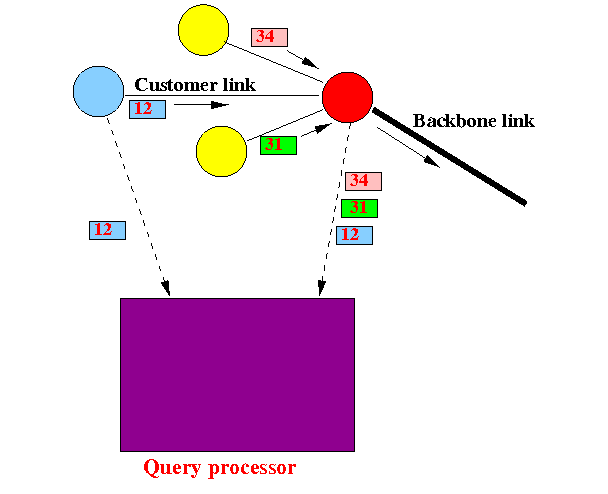
- Query:
- Compute the load on the backbone link average over 1 min period;
- Notify operator if average load exceeds a treshhold T
SQL solution on a materialized database:
SELECT notifyOperator( sum(length) ) FROM PT_backbone GROUP BY getMinute(timestamp) // per minute HAVING sum(length) > T
- How to run the SQL query:
- Use database trigger (CS377 material) !
- A database trigger
"fires" (is run) when a
new tuple is inserted
(deleted or modified - in our case, insertion is the only
reason for firing).
- Result:
terrible system performance:
- Network packets arrives rapidly
In optical links, billions of packets can arrive in 1 second
- Traditional DBMS cannot handle billions of insertions and triggers firings in one second....
- Network packets arrives rapidly
- An ISP (Internet Service Provider)
monitors the load on the following 2 links (among many links):
- The type of query processing model
used in stream DB is called
Continuous Query
- A continuous query
is issued once and...
it is run continuously over the "database" (input data stream) - until it is stopped explicitly
- Example:
- One or more streams of input data.
- Input data temporally buffered in query processor (computer)
- Continuous query (program) operates on data in buffers
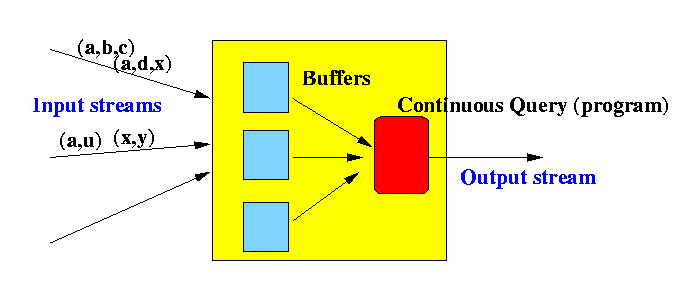
- The way that a
query on
stream data is performed is
fundamentally different
from how a query is performed on traditional databases.
- The following examples will help illustrate the differences
- Some times,
we need to wait an indefinite time
to obtain the exact outcome
in stream query
- Consider the network monitoring problem:

Query:
- Find the fraction of the traffic on the backbone link that originate from the customer link.
NOTE: unit is "packet" (not number of bytes in packet)
SQL-like solution:
(SELECT count(*) FROM PT_backbone AS B, PT_customer as C WHERE C.pkt_id = B.pkt_id) / (SELECT count(*) FROM PT_backbone)
- Problem that arrises when query is processed:
- The query joins packets from
streams
- PT_backbone and
- PT_customer
on their keys (pkt_id) to identify that the source is Customer link
- However,
to perform the join,
you need
both packets in the monitor:
- Problem:
delay is unpredictable...
We may need to buffer a very large amount of data to provide the exact answer to a stream query...
- $64,000 questions:
- How much do you want to pay for the
exact answer ?
- Can you live with an answer that is not exact ?
- How much do you want to pay for the
exact answer ?
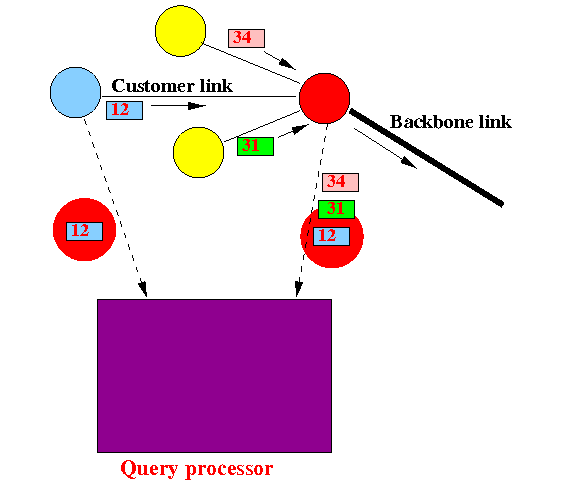
- Problem:
delay is unpredictable...
Conclusion:
- to obtain the exact solution, you may need an unbounded amount of buffer space (to store packets)...
- The query joins packets from
streams
- Some stream queries are
blocking, i.e.,
you need to stop accepting new input
and rewind the data
(and perform a second pass through the existing data)
to produce an exact solution
- Consider the follwoing network monitoring problem:
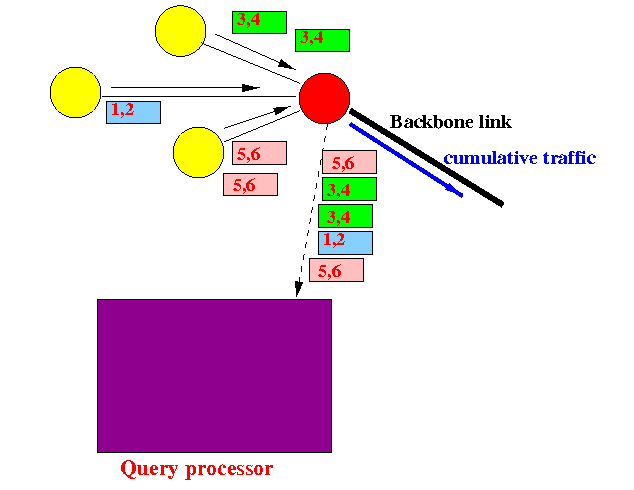
Query:
- Find the connection (Src, Dest) that sends the highest amount of data (number of packets) on the backbone link
Here we will use the number of bytes as unit (no big deal...)
SQL-like solution:
SELECT src_addr, dest_addr, sum(length) FROM PT_backbone GROUP BY src_addr, dest_addr HAVING sum(length) = (SELECT max(sum(length)) FROM PT_backbone GROUP BY src_addr, dest_addr) - Problem that arises when this query is processed
(in real time):
- In the above query, we must
first
find the max(sum(length))
value
To find max(sum(length)), we must make one pass through the collected data and compute the total per (src,dest):
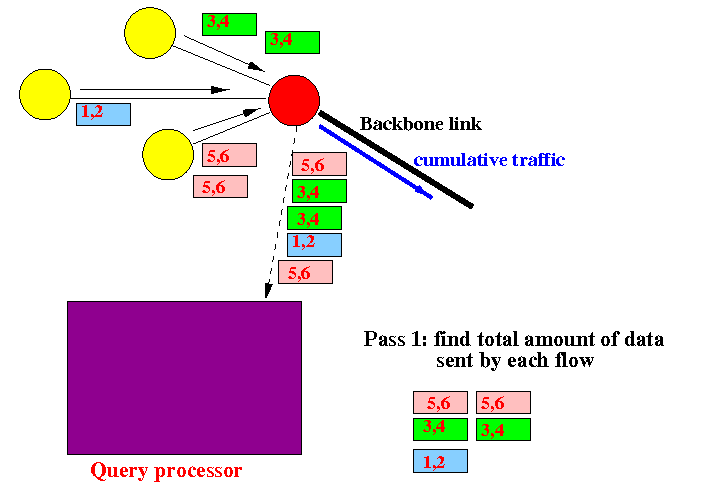
- Only after
you have found the value
max(sum(length)),
you can find the flow ID using
another pass through the
computed totals
- The problem is... a stream query
is processed in
real time...
You may not have to time to do all the operations ("drinking from a fire hose")
- Also, so stream queries may
require
multiple passes
through the streaming data
"Rewind" a flow is not easy to do...
(Because ideally, a stream database system must avoid storing (too much) data)
- In the above query, we must
first
find the max(sum(length))
value
- Consider a relation
R(X,Y)
with 2 attributes
X is the key of the relation
- Consider the following simple
Continuous Query that involves a join
operation:
SELECT * FROM R R1, R R2 // Self-join WHERE R1.X = R2.X
- Interesting fact:
- The accuracy of the self-join query depends on the amount of tuples buffered by the stream query processor !!!!
- Illustrative example:
Processing of the continuous query is done as follows:

- Consider the sample input stream:
- (A,B), (A,C), (A,D), ...
If the continuous query processor buffers one tuple, the output will be: empty !!!
If the continuous query processor buffers two tuples, the output will be: (A,B,A,C), (A,C,A,D), ... !!!
If the continuous query processor buffers two tuple, the output will be: (A,B,A,C), (A,B,A,D), (A,C,A,D), ... !!!
- Basic requirements of stream DB processing:
- Query processing must be performed
online
- in other words:
input data (tuples) comes in continuously
and the data must be
processed immediately
- the output must reflect
the input as soon and as
close as possible
- The amount of storage space required to compute the answer of a continuous query must be bounded
- Query processing must be performed
online
- in other words:
input data (tuples) comes in continuously
and the data must be
processed immediately
- the output must reflect
the input as soon and as
close as possible
- Topics in
Stream Database:
- System building
- Design and implement efficient stream database query processing systems
- Summarization.
- Summaries (or data synopses) is a
concise
(but not completely accurate)
representation
of the original
data set at the expense of some accuracy.
- Summarization techniques include:
sampling,
histograms, and
wavelets
- Summarization techniques are important in stream DB processing
due to storage constraints (summarizes a large amount of data
using small memory space).
- Summary information can also speed up query processing !
- Summaries (or data synopses) is a
concise
(but not completely accurate)
representation
of the original
data set at the expense of some accuracy.
- Online data structures.
- Online data structures are special data structures designed
specifically to handle data streams.
- Develop efficient and effective data structures for stream database
- Online data structures are special data structures designed
specifically to handle data streams.
- Query adaptation and optimization.
- The order of evaluation of the boolean conditions in a query
will affect the speed of the query (e.g., performing
a selection that removes a large number of tuples early
will cut down the number of tuples early and improves
processing speed).
- Continuous queries run over a long period of time...
Input data characteristics can change over such a long period of time (e.g., a selection that filters out a large fraction of tuples hours ago may filter out a little fraction now due to change in input data...)
So the processing steps of contiuous queries may need to be "shuffled" continuously...
How do you design a query processing engine that allow "re-shuffling" of query steps.
- The order of evaluation of the boolean conditions in a query
will affect the speed of the query (e.g., performing
a selection that removes a large number of tuples early
will cut down the number of tuples early and improves
processing speed).
- Query Language for expressing Continuous Queries
- Since most people are familiar with SQL, it is desirable to
use SQL-like languages to express Continuous Queries
- (I'm not a programming language expert and this area is not the most interesting aspect in DB research for me... so I may be brief or omit it entirely :-))
- Since most people are familiar with SQL, it is desirable to
use SQL-like languages to express Continuous Queries
- Blocking operators
- A blocking operator is one that must obtain its entire input set
before it can compute the output
- Typical blocking scenarios are: (1) queries that involves sorting
and (2) queries that involves aggregation
- Note: a query that find the largest or the smallest value
indirectly uses sorted and it is therefore blocking....
- Obviously, input to the continuous query will take forever
to finish arriving, so a blocking operator can't keep
on blocking forever... :-)
- The semantic of such operator must be "re-defined" for a continuous query: what is the result of an aggregation or sort when more data may arrive later (that will surely alter the outcome).
- A blocking operator is one that must obtain its entire input set
before it can compute the output
- System building